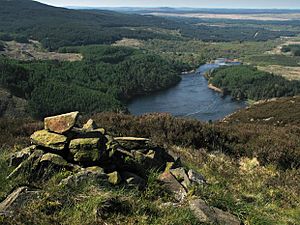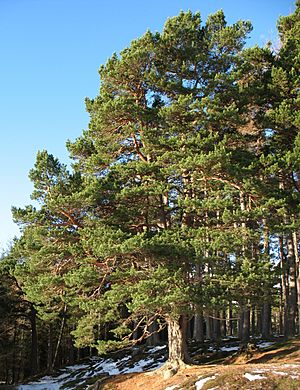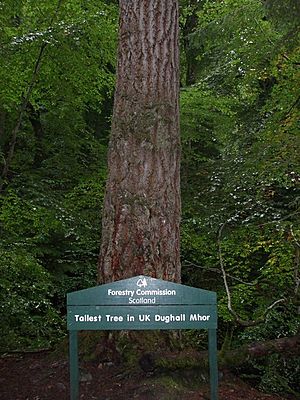Forestry in Scotland facts for kids
Scotland is a great place for trees to grow! It has mild winters, lots of rain, good soil, and hills that protect trees from strong winds. In 2019, about 18.5% of Scotland was covered in trees. This is much more than in 1919, when only 5% of the country had forests. The Scottish Government wants to increase this to 21% by 2032. They plan to plant 15,000 hectares of new trees each year by 2024.
About 4,700 square kilometers of Scotland's forests are owned by the Scottish Government. These are called the National Forest Estate. In 2015, the forestry industry added almost £1 billion to Scotland's economy and employed over 25,000 people.
Contents
A Look Back in Time: Scotland's Forests
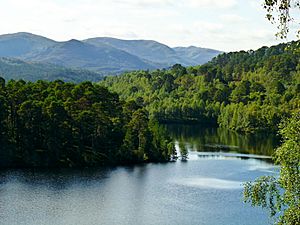
For most of history, people in Scotland cleared forests to create farmland. Also, the climate has changed a lot over thousands of years, which affected where different trees could grow. Because of this, it's hard to know exactly how much forest Scotland naturally had.
Before humans changed things, Scotland's forests probably had lots of Scots pine and birch trees in the north and east. In the warmer, wetter areas to the south and west, there were "Atlantic oakwoods." The Caledonian Forest is the name for the ancient, old-growth forests of Scotland. The Scots pines in this forest are direct descendants of the first pines that arrived in Scotland around 7000 BC. The forest was biggest around 5000 BC. After that, the climate became wetter and windier, which made the forest shrink a lot by 2000 BC. From then on, human activities, like sheep and deer grazing, continued to reduce the forest size.
Forests and the Industrial Revolution
In the 1700s, during the start of the Industrial Revolution, wood was super important for many industries, especially for making iron. Oak wood was especially good for this because it could be turned into charcoal, which was used in big furnaces. To get enough wood, forests were managed using a technique called coppicing. This meant cutting branches from trees close to the ground, allowing new shoots to grow back.
The Bonawe Iron Furnace is a great example of an iron-making site from the 1700s in the Scottish Highlands. The nearby forest at Glen Nant supplied the oak needed for charcoal. Today, Glen Nant is a special nature reserve and shows how woodlands were managed by coppicing.
Rebuilding Forests After Wars
Britain's supply of timber (wood) was very low after World War I because it was hard to import wood. So, the Forestry Commission was created in 1919. Its job was to make sure Britain always had enough timber. The first chairman was Simon Fraser, 14th Lord Lovat. He had a lot of land in Scotland and wanted to help people live in the countryside by linking homes with forestry work.
The plan created small farms, about 4 hectares (10 acres) big, within the new forests. These were rented out cheaply. The idea was to give people jobs working in the forests. This scheme was very successful and helped many families. It slowed down during the Great Depression and almost stopped during World War II. After the Second World War, the focus shifted to building houses for workers, rather than small farms.
During World War II, timber was again in huge demand. More wood was cut from Scotland's forests. Special groups were formed to work in the forests, including the Women's Timber Corps and workers from Belize. After the war, the Forestry Commission worked hard to replant the lost trees, using more machines to help.
Changes in Forestry Management
Over time, the way forestry was managed in Scotland changed. In 1945, the Forestry Act 1945 gave the Scottish Office control over the Forestry Commission's land in Scotland. This was the start of Scotland managing its own forestry policies.
When Scotland gained more political power (called devolution), forestry became a matter for the Scottish Parliament. This led to the creation of Forestry Commission Scotland in 2003, which focused on Scottish forests. In 2019, two new bodies were set up to take over its responsibilities: Forestry and Land Scotland (FLS) and Scottish Forestry.
Tree Species and Forest Animals
Scotland has 31 types of native deciduous trees and shrubs. These include ten types of willow, four types of whitebeam, and three types of birch and cherry. The Scots pine and Common Juniper are the only native conifer trees. Yew trees might also be native.
Unique and Rare Trees
The Arran whitebeams are very special trees found only on the Isle of Arran. Two types, Sorbus arranensis and the Cut-leaved Whitebeam (S. pseudofennica), are among the most endangered tree species in the world! In 1980, there were only 236 Cut-leaved Whitebeams and 283 S. arranensis trees. These trees developed in a complex way from other species. In 2007, a third new hybrid, the Catacol Whitebeam, was discovered on Arran.
Types of Woodland
In 2002, about 81.6% of Scotland's woodlands were coniferous (cone-bearing trees), mostly from plantations of non-native trees. The most commonly planted tree was Sitka spruce, which covered almost half of all forest land. Other common non-native trees included lodgepole pine, larches, and Norway spruce. The native Scots pine covered 11.6% of forest land.
A survey completed in 2012 found that of Scotland's native woodlands:
- 29% were "upland birchwoods."
- 28% were native pinewoods.
- 14% were Wet woodland.
- 8% were "lowland mixed deciduous woodland."
- 6% were upland oakwoods.
Animals in Scottish Forests
Researchers at Stirling University have found over 1000 species living in Scottish forests. Many of these are animals and plants strongly linked to Scotland, such as:
Managing Scotland's Forests
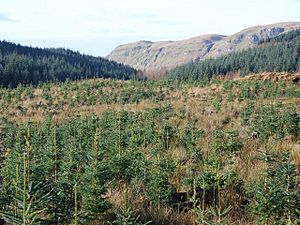
Two main groups are in charge of forestry in Scotland. Both work for the Scottish Government:
- Scottish Forestry: This group sets the rules, policies, and gives support to landowners who have forests.
- Forestry and Land Scotland (FLS): This group manages the national forest estate, which includes both forests and open land. They grow and supply timber. They also work to protect nature, help people access the outdoors, encourage tourism, and support the economy in rural areas. Scottish Forestry oversees FLS.
Scottish Forestry also helps manage the UK Forestry Standard (rules for good forestry) and the Woodland Carbon Code (a way to measure how much carbon trees store). They also give advice on the economics of forestry for Scotland, England, and Wales.
Forests for Fun and Future
Many parts of the National Forest Estate are managed to encourage tourism and outdoor activities. You can find car parks, picnic areas, walking paths, and mountain bike trails. Good examples include Scotland's six forest parks and the 7stanes mountain biking trails.
In 2019, the Scottish Government released a plan for forestry from 2019 to 2029. It has six main goals:
- Making sure forests are managed in a way that can last forever.
- Growing the area of forests, while also thinking about other land uses.
- Making forestry more efficient and productive.
- Helping forests adapt and become stronger against challenges.
- Making forests even better for the environment.
- Getting more people, communities, and businesses involved in creating, managing, and using forests.
The plan aims to increase forest cover to 21% of Scotland by 2032. They want to plant 15,000 hectares of new trees each year by 2024. Within this, they hope to create 3,000 to 5,000 hectares of new native woodlands each year.
Famous and Record-Breaking Trees
The tallest trees in Scotland today are non-native conifers.
- A Douglas fir in Reelig Glen near Inverness is 66.4 meters (218 feet) tall, making it the tallest tree in the UK.
- Another Douglas Fir in Reelig Glen, named Dùghall Mòr (which means "big dark stranger" in Scottish Gaelic), is over 62 meters (203 feet) tall.
- The Stronardron Douglas fir near Dunans Castle in Argyll is 63.79 meters (209 feet) tall.
- The Diana's Grove Grand Fir at Blair Castle is 62.7 meters (206 feet) tall.
- The Hermitage Douglas Fir near Dunkeld is 61.31 meters (201 feet) tall.
The Fortingall Yew in Glen Lyon is believed to be Scotland's oldest tree. It's estimated to be between 3,000 and 5,000 years old!
The Meikleour Beech Hedges in Perth and Kinross were planted in 1745. This European Beech hedge is 530 meters (0.33 miles) long and reaches 30 meters (98 feet) high. It's listed in the Guinness World Records as the tallest and longest hedge on Earth! It's usually trimmed about once every ten years.


